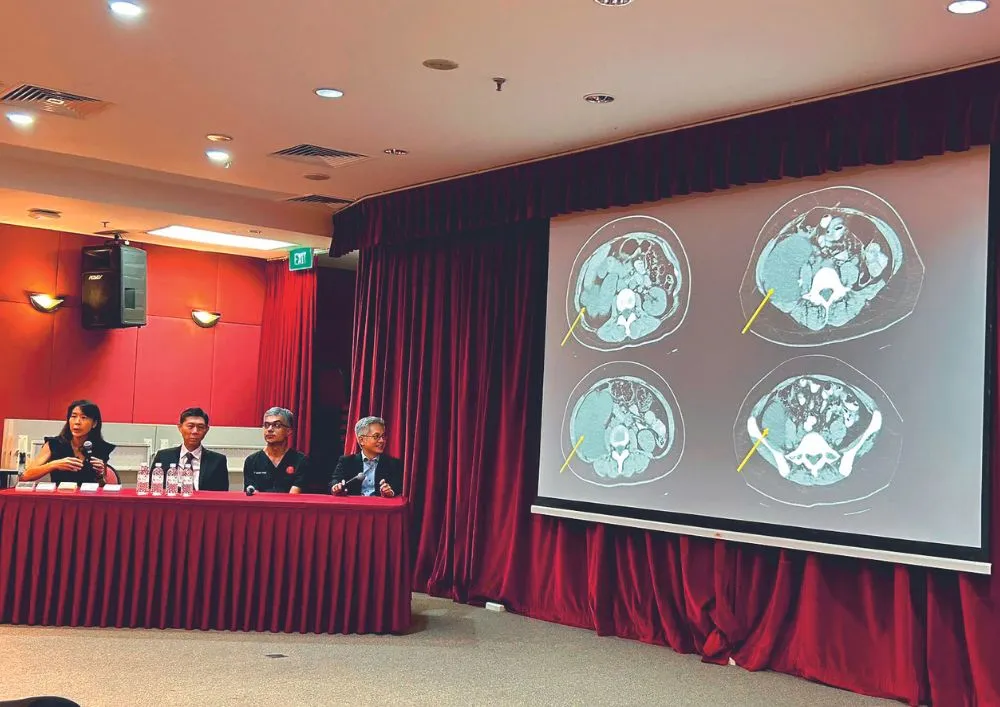News & Articles

When Sarcoma Strikes: Recognising and Treating This Cancer

Uncover insights about this rare cancer that impacts individuals at any age.
Swollen limbs, persistent bone pain and painless abdominal lumps are among the symptoms that have led patients to consult their doctors, resulting in diagnoses of sarcoma. This cancer arises in connective tissues, including muscles, fat cells, blood vessels, nerves, bones and cartilage.
Unlike more common cancers like those of the colon, lung or breast, sarcomas are relatively rare but can become deadly if undetected. They encompass over 70 subtypes and can occur anywhere in the body, from head to toe. Common types include gastrointestinal stromal tumours (GIST) in the digestive system and liposarcomas in the fat cells of limbs or abdomen.
To deepen public understanding of sarcomas, Dr Richard Quek, Senior Consultant in Medical Oncology at Parkway Cancer Centre (PCC); Professor Melissa Teo, General Surgeon and Surgical Oncologist at Melissa Teo Surgery; Dr Gurpal Singh, Orthopaedic Surgeon at the Centre for Orthopaedics and Hip and Knee Surgery; and Dr Lee Kuo Ann, Senior Consultant in Radiation Oncology at PCC, shared their expertise at the PCC Sarcoma Insights Masterclass held on 18 May 2024, at Gleneagles Hospital Lecture Theatre.
Across all ages
"Sarcoma does not discriminate and can affect individuals from young children to the elderly,” explained Dr Quek. Different age groups are susceptible to different types of sarcoma. These include:
- Rhabdomyosarcoma (RMS) - Typically found in the skeletal muscles of arms and legs, mostly seen in children and young adults
- Osteosarcoma - Affects the bones, common among adolescents
- GIST - Most common sarcoma of the intestinal tract affecting middle-aged adults
- Angiosarcoma - Originates in the lining of blood and lymph vessels, often affecting older adults
- Chondrosarcoma - Begins in cartilage cells and usually impacts the elderly
Recognising the symptoms
If you notice a painless lump on your body, do see a doctor as it could be a form of sarcoma. “Lumps can grow very big, more than 5cm,” pointed out Dr Quek. Bone sarcoma, on the other hand, can cause pain as the bones may fracture. However, it is just as common for patients not to experience any symptoms at all.
Doctors suspect sarcoma in adolescents or young adults when they develop a big lump in areas such as the limbs, back of the abdomen and pelvis, as this indicates a suspicious soft tissue mass. Those with bone sarcoma usually suffer persistent pain, especially at night or while resting. “If a young person has these symptoms, do not brush it off as mere sports injuries,” advised Dr Quek.
Treating the disease
For suspected sarcomas, comprehensive scans and tissue samples are essential for diagnosis and molecular testing to identify the type, size, extent and severity of the cancer. The pathologist's critical analysis of these lab results is vital in shaping the treatment strategy for the disease. A multidisciplinary team — comprising medical oncologist, surgeon and radiation oncologist — will then discuss and decide on the most appropriate treatment plans.
Given the diversity of sarcoma subtypes, treatment strategies vary greatly and may include chemotherapy, radiation therapy, immunotherapy and surgery.
Case study: “I thought I was just getting fat”
Prof Teo has encountered patients who mistook significant tissue mass growth for a ‘beer belly’ or bloating. Unfortunately, in some of these instances, the underlying cause was a large retroperitoneal sarcoma (RPS), which develops in the abdominal cavity. Organs affected by RPS can include the pancreas, kidneys, part of the colon or small intestines, and blood vessels. Unlike the more obvious growth that appears in the arms and legs, RPS may not be immediately recognized as a malignancy, leading to delayed diagnosis and adversely impacting survival rates, said Prof Teo.
Surgery is the primary treatment for most sarcomas, and in the case of RPS, challenges arise when other affected organs or parts of them have to be removed together with the cancerous tissue masses. “We must carefully consider how to safely remove the involved organs to achieve complete tumour resection, while simultaneously preserving important organs to maintain the patient’s quality of life,” explained Prof Teo. She emphasized that completely removing the tumour with clear margins is critical, as this significantly increases the patient’s chances for long-term survival.
Case study: “I went rock climbing with an artificial limb”
Understanding proton therapy
Radiotherapy, also known as radiation therapy, employs radiation beams to eradicate cancer cells and can be administered before or after surgery. However, radiotherapy can also lead to various side effects due to the exposure to surrounding organs. Children and young adults, in particular, are at greater risk of impaired growth and cognitive functions, and future radiation-induced cancer. “The less radiation we deliver to unaffected tissues, the better,” said Dr Lee.
Proton therapy offers a solution to these concerns. Introduced in Singapore in 2023, proton therapy represents a sophisticated advancement in radiation treatment. It targets cancer cells more precisely and inflicts less damage on healthy tissues. Unlike conventional radiation — where beams pass through the target and continue outward, causing potential harm — proton therapy beams release their energy specifically at the tumour site and then stop. “Nothing comes out on the other side, sparing normal tissue,” said Dr Lee.
Dr Lee illustrated the effectiveness of proton therapy with a case study of a 25-year-old patient who had an inoperable tumour in the muscle of the mouth, diagnosed as rhabdomyosarcoma. This affected her palate and tongue. Under a proton therapy plan, the patient responded positively. “She tolerated treatment with no loss of weight, no loss of taste and no development of mouth ulcers — common side effects associated with conventional radiation,” noted Dr Lee.
| POSTED IN | Cancer Prevention, Cancer Treatments |
| TAGS | cancer lump, cancer quality of life, cancer survivorship, primary bone cancer, rare cancer, sarcoma |
| READ MORE ABOUT | Sarcoma |
| PUBLISHED | 01 August 2024 |
